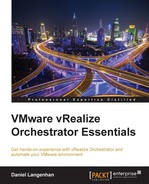After downloading the Orchestrator Appliance, we need to deploy it. In the following steps, we will show you how to do this in vCenter and with VMware Workstation.
To make the best use of Orchestrator, its best to deploy it into your vSphere infrastructure. For this, we deploy it with vCenter.
- Open your vSphere Web Client and log in.
- Select a host or cluster that should host the Orchestrator Appliance.
- Right-click the Host or Cluster and select Deploy OVF Template.
- The deploy wizard will start and ask you the typical OVF questions:
- Accept the EULA
- Choose the VM name and the VM folder where it will be stored
- Select the storage and network it should connect to. Make sure that you select a static IP
- The Customize template step will now ask you about some more Orchestrator-specific details. You will be asked to provide a new password for the root user. The root user is used to connect to the vRO appliance operating system or the web console.
- The other password that is needed is for the vRO Configurator interface. We will have a quick look at that in Chapter 3, Integrating Orchestrator with vSphere.
- The last piece of information needed is the network information for the new VM. The following screenshot shows an example of the Customize template step:

- The last step summarizes all the settings and lets you power on the VM after creation. Click on Finish and wait until the VM is deployed and powered on.
For learning how to use Orchestrator, or for testing purposes, you can deploy Orchestrator using VMware Workstation (Fusion for MAC users). The process is pretty simple:
- Download the Orchestrator Appliance on to your desktop.
- Double-click on the OVA file.
- The import wizard now asks you for a name and location of your local file structure for this VM. Chose a location and click on Import.
- Accept the EULA.
- Wait until the import has finished.
- Click on Edit virtual machine settings.
- Select Network Adapter.
- Chose the correct network (Bridged, NAT, or Host only) for this VM. I typically use Host Only.

- Click on OK to exit the settings.
- Power on the VM.
- Watch the boot screen. At some stage, the boot will stop and you will be prompted for the
rootpassword. Enter a new password and confirm it. - After a moment, you will be asked for the password for the Orchestrator Configurator. Enter a new password and confirm it.
- After this, the boot process should finish, and you should see the Orchestrator Appliance DHCP IP.
If you would like to configure the VM with a fixed IP, access the appliance configuration, as shown on the console screen (see the next section).
..................Content has been hidden....................
You can't read the all page of ebook, please click here login for view all page.

